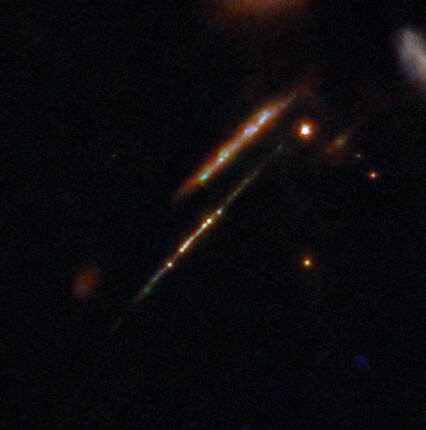Astronomers have discovered the most distant, and so the oldest, known stellar clusters. This is the first time astronomers have seen star clusters from before the first half a billion years of the Universe. The light of these gravitationally bound groups of stars comes to us from just 460 million years after the Big Bang.
Two factors have been crucial to the discovery. The extremely keen infrared eye of JWST has been able to see farther than any telescope before. And the phenomenon of gravitational lensing. A massive foreground galaxy cluster warped space-time to such a degree that, just like a glass lens, it magnified and distorted this distant galaxy.
From the distorted image, stretched out like an arc, the team was able to detect star clusters.
The name of the project is Cosmic Gems – and it is very apt. The clusters appear to contribute to the majority of ultraviolet light coming from the galaxy, telling astronomers something about the wider cosmos.

The gravitationally-lensed arc showing off the star clusters.
Image Credit: ESA/Webb, NASA & CSA, L. Bradley (STScI), A. Adamo (Stockholm University) and the Cosmic Spring collaboration
“These galaxies are thought to be a prime source of the intense radiation that reionised the early Universe,” lead author Angela Adamo, of Stockholm University and the Oskar Klein Centre in Sweden, said in a statement. “What is special about the Cosmic Gems arc is that thanks to gravitational lensing we can actually resolve the galaxy down to parsec scales!”
Reionization is the epoch from the formation of the first stars to about 1 billion years after the Big Bang when the neutral hydrogen gas dominated the universe. The light of those first stars and galaxies stripped the electrons from the hydrogen (ionizing it for the second time since the Big Bang). To do that, you need energetic light, such as the ultraviolet emissions from hot and very young stars.
The international team was able to determine that the star clusters are massive, located in a small region of their host galaxy, and very dense – significantly denser than the star clusters that are found in the nearer universe.
“These results provide direct evidence that indicates proto-globular clusters formed in faint galaxies during the reionisation era, which contributes to our understanding of how these galaxies have succeeded in reionising the Universe,” explained Adamo.
“This discovery also places important constraints on the formation of globular clusters and their initial properties. For instance, the high stellar densities found in the clusters provide us with the first indication of the processes taking place in their interiors, giving new insights into the possible formation of very massive stars and black hole seeds, which are both important for galaxy evolution.”
The team expect this to be only the first system of distant star clusters. Many more, some that could be even more distant, might soon be discovered with JWST.
“I am confident there are other systems like this waiting to be uncovered in the early Universe, enabling us to further our understanding of early galaxies,” said Eros Vanzella from the INAF – Astrophysics and Space Science Observatory of Bologna, Italy, one of the main contributors to the work.
A paper describing the results is published in the journal Nature.
Source Link: Oldest Ever Star Clusters From When Universe Was 460 Million Years Old Discovered